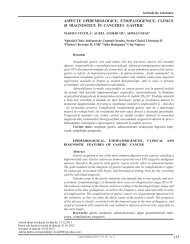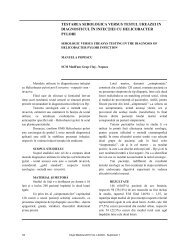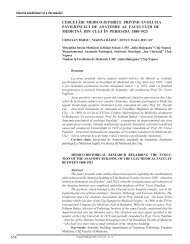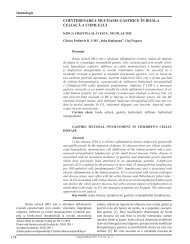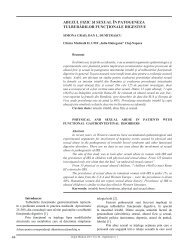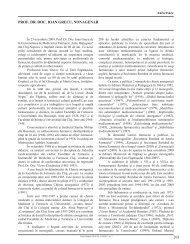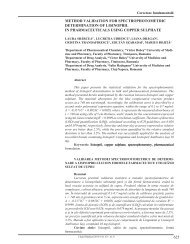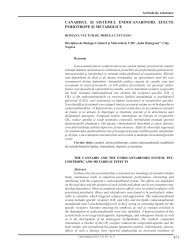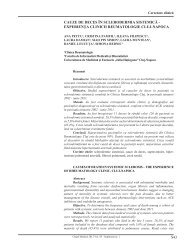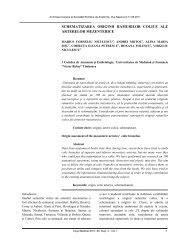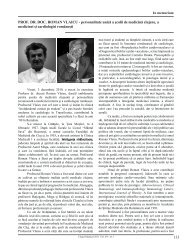COSMINA-IOANA BONDOR, INA MARIA KACSO, ALINA
COSMINA-IOANA BONDOR, INA MARIA KACSO, ALINA
COSMINA-IOANA BONDOR, INA MARIA KACSO, ALINA
- No tags were found...
Create successful ePaper yourself
Turn your PDF publications into a flip-book with our unique Google optimized e-Paper software.
Phisiologyof Nephrology Mihai Manasia Cluj and 48 patients with type 2 diabetes withoutdiabetic neuropathy. Exclusion criteria were: chronic renal disease other thandiabetic nephropathy, diabetic nephropathy stage 4-5 KDOQI, the presence of acuteinflammatory/infectious, uncontrolled hypertension.Results. In patients with neuropathy plasma adiponectin was significantlycorrelated with lipid peroxides-malondialdehyde r=-0.42, p=0.03, with catalaser=0.56, p=0.009, with high-density lipoprotein cholesterol r=0.53, p=0.005 andglycated hemoglobin r=-0.54, p=0.005. Lipid peroxides - malondialdehyde wassignificantly correlated with age r=-0.46, p=0.02, glycated hemoglobin r=-0.54,p=0.005; abdominal circumference r=-0.39, p=0.05. Superoxide dismutase wassignificantly correlated with blood glucose r=-0.84, p
Basic researchiunie-iulie 2011.Neuropatia diabetică a fost diagnosticată pe bazasimptomelor, istoricului medical şi a unui examen fizic.Pacienţii din lotul I au prezentat atât neuropatie periferică,cât şi vegetativă şi focală. u fost efectuate şi înregistratedatele rezultate din examinarea clinică, au fost măsurateTS şi TD, au fost efectuate măsurători antropometrice(înălţime, greutate, circumferinţa abdominală), s-au consemnatantecedentele personale şi tratamentul (inhibitoriai enzimei de conversie (IEC), (I), antagonişti receptori aiangiotensinei II (R), statine, metformin, sulfonilureeşi insulină). nalizele de rutină: tabloul lipidic, nivelulglicemic au fost obţinute prin analiză automată, raportulalbumină urinară/creatinină urinară (U/CU) a fost analizatprin imunoturbidimetrie [9], creatinuria cu metodaJaffe [10], adiponectina din plasmă prin metoda Cyber-Elisa [11], hemoglobina glicozilată (Hb1c) cu metodacromatografică-colorimetrică Biogamma [12], proteina Creactivă (CRP) cu metoda latex-imunoturbidimetrică [13],PL-MD cu metoda colorimetrică cu acid thiobarbituric[14], catalaza (T) prin urmărirea modificării absorbanţeiunei soluţii de H 2O 2[15], superoxid dismutaza (SOD) cumetoda bazată pe inhibiţia a 50% a formării de nicotinamidadenin dinucleotide-fenazinemetosulfat nitrotetrazoliumblue (NBT) formazan [16]. nalizele de laborator aufost efectuate în laboratorul de Imunologie al SpitaluluiJudeţean de Urgenţă, Cluj şi în laboratorul pentru studiulSO al Disciplinei de Fiziologie a Universităţii de Medicinăşi Farmacie Iuliu Haţieganu Cluj-Napoca. Rata de filtrareglomerulară (RFG) a fost estimată în concordanţă cuformula MDRD [17]. fost determinat U/U U/CU din urinacolectată dimineaţa.Analiza statisticăNormalitatea distribuţiei datelor a fost estimată cutestul Kolmogorov-Smirnov. Rezultatele au fost prezentateca medii aritmetice ± deviaţia standard sau mediane(percentilele 25%-75%) pentru variabile cantitative şi cufrecvenţe absolute şi relative procentuale pentru variabilelecalitative. Testul T Student sau testul Mann-Whitney Ua fost aplicat la compararea a două medii în funcţie detipul distribuţiei variabilelor comparate. Testul Hi-pătratsau testul Fisher exact a fost aplicat pentru tabelele decontingenţă. Corelaţia a fost apreciată prin coeficientul decorelaţie Pearson sau Spearman. naliza multivariată afost realizată cu regresie liniară, metoda stepwise. fostprezentat coeficientul b şi intervalul de încredere de 95%.Nivelul de semnificaţie ales a fost 0,05. Datele au fostevaluate utilizând aplicaţia SPSS 15.0.Rezultateu fost comparaţi parametri între loturile caz şimartor. Rezultatele au fost prezentate în Tabelul I. RFGa fost semnificativ mai mică la lotul I, faţă de lotul II(p=0,03). u mai fost diferenţe între cele două loturi, darnu semnificative în ceea ce priveşte Hb1c şi CRP, ambelefiind mai mari la lotul I. Ceilalţi parametri testaţi nu auTabel I. Compararea lotului I cu lotul II.ParametriLotul I(n=26)Clujul Medical 2013 Vol. 86 - Supplement no. 1Lotul II(n=48)a) Indicatori antropometriciVârsta (ani) 66,77±9,77 64,33±11,78 0,37Genul masculin n (%) 18 (69,2) 30 (62,5) 0,56Vechimea diabetului (luni) 11 (7-19,25) 8 (6-12) 0,11IMC (kg/m 2 ) 30,99±5,90 31,71±6,27 0,63Circumferinţa abdominală (cm) 109,13±14,93 106,42±13,60 0,43b) lţi indicatoriSindrom X metabolic n (%) 17 (89,5) 31 (83,8) 0,57TS (mmHg) 128,40±18,58 133,65±17,34 0,28TD (mmHg) 74,20±7,86 78,23±9,59 0,10Retinopatie diabetică n (%) 9 (50,00) 12 (50,00) 1,00c) TratamentIEC n (%) 16 (64,00) 23 (47,90) 0,19R n (%) 6 (24,00) 11 (22,90) 0,92IEC sau R n (%) 21 (80,80) 34 (70,80) 0,35Statine n (%) 15 (60,00) 31 (64,60) 0,70Metformin n (%) 9 (36,00) 17 (35,40) 0,96Insulină n (%) 14 (56,00) 21 (43,80) 0,32Sulfoniluree n (%) 5 (20,00) 19 (39,60) 0,09d) Indicatori biochimiciRFG (ml/min) 74,82±29,54 92,41±36,13 0,03U/CU (mg/g) 24,13 (5,25-62,98) 20,35 (6,85-110,56) 0,80Hb1C (%) 8,04±1,54 7,26±1,74 0,07LDL colesterol (mg/dl) 107,15±43,45 115,44±41,30 0,42HDL colesterol (mg/dl) 40,85±8,97 45,52±13,55 0,12Trigliceride (mg/dl) 142 (107,5-218) 147,50 (99,75-208) 0,61CRP (mg/dl) 0,46 (0,20-0,86) 0,28 (0,12-0,47) 0,09diponectina plasmatică (µg/ml) 6,20 (2,61-9,00) 6,07 (3,57-10,77) 0,55PL-MD (nmol/ml) 3,91±1,08 3,89±1,55 0,94T (U/mg proteină) 3,09±0,87 3,08±0,74 0,98SOD (U/mg pro) 629,20±182,09 650,52±125,46 0,84pS17
Phisiologydiferit semnificativ între loturi.La lotul II, 50% dintre pacienţi au avut RFG ≥90ml/min comparativ cu 30,8% în lotul I. La lotul I, 34,6%dintre pacienţi au avut RFG
Basic researchAcknowledgementsThe author CB was partly supported by European Social Fundwithin the Sectorial Operational Program - Human ResourcesDevelopment 2007-2013-POSDRU /89/1.5/S/58965.Bibliografie1. Whiting DR, Guariguata L, Weil C, Shaw J. IDF diabetes atlas:global estimates of the prevalence of diabetes for 2011 and 2030.Diabetes Res Clin Pract, 2011; 94(3):311-321.2. Fowler SP, Williams K, Resendez RG, Hunt KJ, Hazuda HP,Stern MP. Fueling the obesity epidemic? rtificially sweetenedbeverage use and long-term weight gain. Obesity (Silver Spring),2008; 16:1894-1900.3. Yan SF, Ramasamy R, Bucciarelli LG, et al. RGE and itsligands: a lasting memory in diabetic complications? Diab VascDis Res, 2004; 1:10-20.4. Cheţa D, Mihai . Complicaţiile cronice ale diabetului zaharat:generalităţi, sistematizare, patogenie. În Şerban V, editor. Tratatromân de boli metabolice 2. Ed. Brumar, Timişoara, 2011.5. Goldberg RB. Cytokine and cytokine-like inflammationmarkers, endothelial dysfunction, and imbalanced coagulation indevelopment of diabetes and its complications. J Clin EndocrinolMetab, 2009; 94(9):3171-3182.6. Hopkins T, Ouchi N, Shibata R, Walsh K. diponectinactions in the cardiovascular system. Cardiovasc Res, 2007;74(1):11-18.7. Zubair M, Malik , hmad J. Plasma adiponectin, IL-6,hsCRP, and TNF-α levels in subject with diabetic foot and theircorrelation with clinical variables in a North Indian tertiary carehospital. Indian J Endocrinol Metab, 2012; 16(5):769-776.8. hmad J, Zubair M, Malik , Siddiqui M, Wangnoo SK.Cathepsin-D, adiponectin, TNF-α, IL-6 and hsCRP plasma levelsin subjects with diabetic foot and possible correlation with clinicalvariables: a multicentric study. Foot (Edinb), 2012; 22(3):194-199.9. Jury DR, Mikkelsen DJ, Dunn PJ. Prozone effect and theimmunoturbidimetric measurement of albumin in urine. ClinChem, 1990; 36(8 Pt 1):1518-1519.10. McLean M, Gallwas J, Hendrixson M. Evaluation of anautomated creatininase creatinine procedure. Clin Chem, 1973;19(6):623-625.11. rita Y, Kihara S, Ouchi N, et al. Paradoxical decrease ofan adipose-specific protein, adiponectin, in obesity. BiochemBiophys Res Commun, 1999; 257:79-83.12. Welch SG, Boucher BJ. rapid micro-scale method for themeasurement of Haemoglobin 1(a+b+c). Diabetologia, 1978;14(3):209-211.13. Borque L, Bellod L, Rus , Seco ML, Galisteo-González F.Development and validation of an automated and ultrasensitiveimmunoturbidimetric assay for C-reactive protein. Clin Chem,2000; 46(11):1839-1842.14. Conti M, Moran PC, Levillain P, et al. Improved fluorimetricdetermination of malondialdehyde. Clin Chem, 1991; 37:1273-1275.15. Pippenger CE, Browne RW, rmstrong D. Regulatoryantioxidant enzymes. In: Methods in Molecular Biology, vol. 108:Free Radicals and ntioxidant Protocols D.rmstrong. Totowa(NJ): Humana Press Inc, 1993; 299-311.16. Beyer WF Jr, Fridovich I. ssaying for superoxide dismutaseactivity: some large consequences of minor changes in conditions.nal Biochem, 1987; 161(2):559-566.17. Levey S, Greene T, Kusek JW, Beck GJ. simplifiedequation to predict glomerular filtration rate from serum creatinine.J m Soc Nephrol, 2000; 11:828-830.18. Stephens JW, Gable DR, Hurel SJ, Miller GJ, Cooper J,Humphries SE. Increased plasma markers of oxidative stress areassociated with coronary heart disease in males with diabetesmellitus and with 10-year risk in a prospective sample of males.Clin Chem, 2006; 52:446-452.19. Jung TW, Lee JY, Shim WS, et al. diponectin protectshuman neuroblastoma SH-SY5Y cells against acetaldehydeinducedcytotoxicity. Biochem Pharmacol, 2006; 72:616-623.20. Han SH, Quon MJ, Kim J, Koh KK. diponectin andcardiovascular disease: response to therapeutic interventions. Jm Coll Cardiol, 2007; 49:531-538.21. lp H, Varol S, Celik MM, et al. Protective effects ofbeta glucan and gliclazide on brain tissue and sciatic nerve ofdiabetic rats induced by streptozosin. Exp Diabetes Res, 2012;2012:230342.22. El Boghdady N, Badr G. Evaluation of oxidative stressmarkers and vascular risk factors in patients with diabeticperipheral neuropathy. Cell Biochem Funct, 2012; 30(4):328-334.23. rya K, Pokharia D, Tripathi K. Relationship betweenoxidative stress and apoptotic markers in lymphocytes of diabeticpatients with chronic non healing wound. Diabetes Res lin Clin Pract,2011; 94(3):377-384.24. Matsuda M, Kawasaki F, Inoue H, et al. Possible contributionof adipocytokines on diabetic neuropathy. Diabetes Res ClinPract, 2004; 66 Suppl 1:S121-123.25. Kato K, Osawa H, Ochi M, et al. Serum total and highmolecular weight adiponectin levels are correlated with theseverity of diabetic retinopathy and nephropathy. Clin Endocrinol(Oxf), 2008; 68(3):442-449.26. Jung CH, Kim BY, Kim CH, Kang SK, Jung SH, Mok JO.ssociation of serum adipocytokine levels with cardiac autonomicneuropathy in type 2 diabetic patients. Cardiovasc Diabetol, 2012;11:24.27. Guebre-Egziabher F, Bernhard J, Funahashi T, Hadj-issa, Fouque D. diponectin in chronic kidney disease is relatedmore to metabolic disturbances than to decline in renal function.Nephrol DialTransplant, 2005; 20(1):129-134.28. Schalkwijk CG, Chaturvedi N, Schram MT, Fuller JH,Stehouwer CD. diponectin is inversely associated with renalfunction in type 1 diabetic patients. J Clin Endocrinol Metab,2006; 91(1):129-135.29. Komaba H, Igaki N, Goto S, et al. Increased serum highmolecular-weightcomplex of adiponectin in type 2 diabeticpatients with impaired renal function. m J Nephrol, 2006;26(5):476-482.30. Norata GD, Baragetti I, Raselli S, et al. Plasma adiponectinlevels in chronic kidney disease patients: Relation with molecularinflammatory profile and metabolic status. Nutr Metab CardiovascDis, 2010; 20(1):56-63.31. Kacso IM, Bondor CI, Kacso G. Plasma adiponectin is relatedto the progression of kidney disease in type 2 diabetes patients.Scand J Clin Lab Invest, 2012; 72(4):333-339.Clujul Medical 2013 Vol. 86 - Supplement no. 1S19



